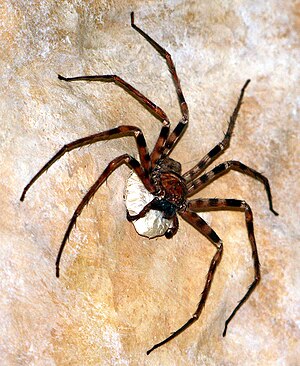Heteropoda maxima
| Heteropoda maxima | ||||||||||||
|---|---|---|---|---|---|---|---|---|---|---|---|---|

Heteropoda maxima , female |
||||||||||||
| Systematics | ||||||||||||
|
||||||||||||
| Scientific name | ||||||||||||
| Heteropoda maxima | ||||||||||||
| Hunter , 2001 |
Heteropoda maxima is a species of the genus Heteropoda within the family of giant crab spiders (Sparassidae) and probably the largest giant crab spider in the world. It occurs in the Laotian province of Khammuan (Cammon), which is why it is sometimes called the Laotian giant crab spider in German. In its habitat it mainly inhabits caves. The eyes of this species are not reduced in contrast to those of other cave-dwelling spiders.
features
The most striking feature of the species is its extraordinary size. Females reach a body length of up to 46 millimeters, males remain slightly smaller and have a body length of around 30 millimeters. The leg span is between 25 and 30 centimeters. Both sexes are of the same color. The basic color is brownish-yellow. The front part of the body ( prosoma ) has several irregular dark spots and a dark fovea in the front area . Behind the fovea there is a dark and directly behind it a light transverse band. The abdomen ( opisthosoma ) is slightly darker than the front body and has two pair of darker depressions but no noticeable pattern. The chelicerae , the labium and the coxae of the pedipalps are dark red-brown. The legs are curled and have dark spots , especially on the outer edge of the femora .
Structure of the sexual organs
In male spiders, the last limb of the two pedipalps, originally the foot limb, is converted into a mostly three-part palp organ. This palp organ is called the globe and contains a cavity inside for the transport of the sperm. The first sclerite, the cymbium, covers the middle sclerite of the globe, which is called the tegulum. In Heteropoda maxima , the cymbium is three times as long as the tegulum. The embolus, the actual sperm-transferring organ, follows at the tip of the globe.
The epigyne (external female sex organ) of the female spider consists of several sclerotized parts, namely a cover and an insertion opening and sits on the abdomen of the abdomen (opisthosoma). Only the male secondary sex organ, the embolus on the male's pedipalp, fits into this opening like a key. The epigyne of Heteropoda maxima has two characteristic ribbon-like projections directed forward.
Similar species
Very similar to Heteropoda maxima are the cave-dwelling species Heteropoda aemulans , also with very long legs, but smaller in structure of the prosoma and opisthosoma, and Heteropoda steineri , with much smaller eyes than H. maxima .
Way of life
Heteropoda maxima appears very large, but this is mainly due to its leg span. Their legs are thin and are used for rapid locomotion. Like almost all spiders, Heteropoda maxima is predatory . No safety nets are made, but the prey animals are hunted freely. However, in contrast to those of other cave-dwelling spiders, for example the related species Sinopoda microphthalma , the eyes of this species are not reduced. This indicates that the spider does not only live in the dark in the depths of the caves, but can also and especially be found at the cave entrance, in smaller grottos or even outdoors. In addition to optical perception, the spider tracks down its prey mainly through the vibrations that it causes. Like all spiders, Heteropoda maxima is poisonous and gives its prey a venomous bite with its chelicerae (jaw claws). The immobile prey is then consumed by the spider.
But their poison is not enough to seriously endanger a person. It is therefore considered to be harmless to humans. Neither are there reports of bites in the area where she lives as she is more likely to run away.
Web links
Heteropoda maxima in the World Spider Catalog
literature
- Peter Jäger: A new species of Heteropoda (Araneae, Sparassidae, Heteropodinae) from Laos, the largest huntsman spider? Muséum national d'Histoire naturelle, Zoosystema, 23 (3), 2001, pp. 461-465, ISSN 1280-9551 ( PDF ).
Individual evidence
- ↑ a b c d e Peter Jäger: A new species of Heteropoda (Araneae, Sparassidae, Heteropodinae) from Laos, the largest huntsman spider? Muséum national d'Histoire naturelle, Zoosystema, 23 (3), 2001, pp. 461-465, ISSN 1280-9551 ( PDF ).
- ↑ Steffen Bayer & Peter Jäger: Heteropoda species from limestone caves in Laos (Araneae: Sparassidae: Heteropodinae). Zootaxa, 2143, 1, pp. 1-23, 2009.